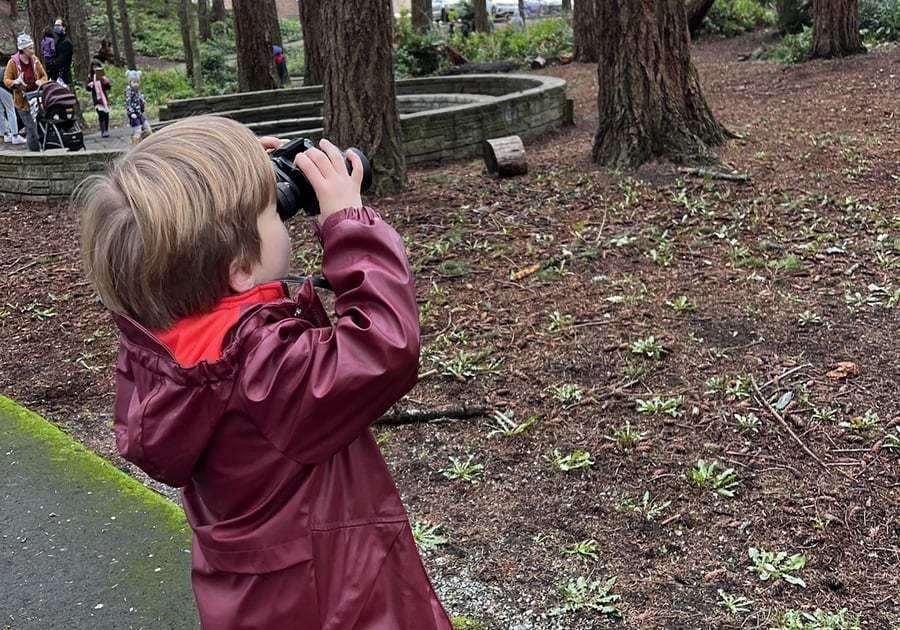Special Thanks to MacaroniKID Renton - Newcastle - Mercer Island for sharing this article.
If your kids are fascinated by the whir of a hummingbird’s wings or the magic of owls, you may have a future birder in your nest. And, there’s no better way to introduce kids to birdwatching than the Great Backyard Bird Count.
The Great Backyard Bird Count is a free, nationwide event that runs February 16 to 19, 2024. To participate, all you need to do is spend 15 minutes listening for birds outdoors. So if your family gives a “hoot” about birds, save the date and be part of the count!
To get tips on birdwatching with kids, we reached out to the pros at the Environmental Science Center (ESC). A nonprofit, ESC offers environmental education programs for all ages in Renton and Burien, Washington. Here’s a snapshot of our conversation with ESC Community Engagement Manager Katy Kachmarik.
What is the Great Backyard Bird Count?
The Great Backyard Bird Count is a way to get everyone outside to spend time in nature, build appreciation for local bird populations, and collect data to help scientists better understand migration patterns.
Anyone can participate in the Great Backyard Bird Count! All you have to do is spend at least 15 minutes looking and listening for birds during the weekend of February 16 to 19, 2024. Even if you’re not a seasoned birdwatcher, you can use apps like Merlin to help you identify birds by using the microphone on your smartphone or tablet. Once you spend time looking and listening for birds, you can upload which species you saw and heard, either on the Ebird app or online.
What can children and teens learn during the Great Backyard Bird Count?
Spending time outside in nature is how we build connections with our local wildlife and ecosystems. Kids might learn something new about the natural world where they live. They might learn how to identify a new bird call, that there’s a tree near them that they’ve never seen before, or that they can be a scientist and advocate for their community.
Did you know? Participating in the Great Backyard Bird Count contributes to science.
Anyone who participates in the Great Backyard Bird Count is contributing to the scientific understanding of bird populations. One of the best ways to understand animal behavior is by knowing where they can be found at any given time of year. By better understanding where bird populations are, when they are there, and what they are doing, we can make better decisions to protect those populations and the habitats they rely on.
The Great Backyard Bird Count happens before the large winter to spring migration. For many places, this means that we can capture data about bird populations that are only there for the winter season. Since winter is usually when we spend more time inside, there is less data about which bird species are in any area at this time of year.
What excites kids most about the Great Backyard Bird Count?
Participating in the Great Backyard Bird Count gives kids a chance to get excited about animals while seeing themselves as being a part of science and nature. Kids have a great natural affinity and enthusiasm for nature and wildlife. They get excited to find a new bird, or find evidence of wildlife outside, or even learn about other animals that are very different from us.
Kids of all ages can also learn and practice their social-emotional learning skills, like using empathy. They use their great affinity for empathy to connect with wildlife and nature in ways that are harder for adults to do.
Most importantly, I have yet to come across anyone under the age of 14 who was not over the moon excited to use binoculars! These are tools that many youth don’t get to use frequently, so looking through a pair to see things close up, or far away if turned around, is a great exploration in itself.
What are unexpected places where families can observe birds?
Birdwatching is one of those great activities that can happen anywhere! Even if you don’t have a backyard, any place that has bushes or trees will have birds.
My favorite place to bird watch is from the comfort of my apartment. On my apartment balcony, I have set up a few potted plants and a shallow dish of water. By providing water and a little bit of shelter, you attract wildlife. When I first put out a small plate of water, I started to see a drastic increase in the sheer number and species of birds that I could watch while sitting on my couch.
A lot of people think of nature as being something we have to go to, rather than being a part of our everyday experiences. Nature can be found in the cities we live in and is all around us; we just have to take the time to stop, notice, and appreciate it.
Local Tip: Liberty Park, in Renton, is a great place to play on the playground and still see anywhere from 5-20 different species of birds at a time right in the heart of the city!
Live in Southeast King County? Participate in Bird Fest in Burien!
Bird Fest is a FREE, family-friendly festival on February 17 from 10 a.m. to 2 p.m. Each year, ESC presents the event in partnership with the City of Burien to celebrate the Great Backyard Bird Count.
- Bird Fest hosts facilitated bird walks to help you learn how to identify local species by sight and sound, as well as a family nature hike that’s great for kids ages 2-10.
- Throughout the day, ESC will have presentations about different bird species, how to attract wildlife to your yard, and birdwatching 101 that will be great for all ages, but particularly for kids ages 8+.
- More community organizations will be there to share information about opportunities around birds, gardening, wildlife viewing, and more while also offering hands-on science activities and crafts for all ages.
- Bird Fest is FREE and open to all with no registration required. Just drop by the community center to join the fun! Learn more here.
Tips to start birdwatching with preschoolers
Preschool age kids love to explore the world around them and do so in a wide range of ways. One tip to introduce young kids to birdwatching is to go on nature walks together. Let them explore how leaves feel differently from tree to tree, what colors they can find, digging in the dirt, and however they show you how they want to explore (even if it means getting messy).
Then, engage their curiosity with stories about birds, practice bird calls together, and even set up live camera streams of birds on places like Explore.org in the background while they play at home.
Tips to start birdwatching with ages school-age kids
Just like with younger kids, nature hikes or short walks are a great way to begin. Older kids can practice their skills of observation, reflection, patience, and curiosity. They benefit from both time spent outside alone as well as time spent with adults they trust. When they see adults modeling the importance of spending time outside, they are more likely to exhibit that behavior throughout their lives.
One tip for older kids is to introduce technology for exploration with birds. Using binoculars to practice looking at birds, plants, stars, etc. is a great way to peak their interest and give them the responsibility of using a scientific tool.
Additionally, technology like smart phone apps, can be great learning tools! Apps, like Merlin, can be used with just the microphone on a smartphone or tablet to help identify bird calls in your area. Or, Ebird is the real-world version of Pokemon Go, where you can check off the different species you see and hear. It may even inspire kids to learn how to identify new species over time.
Explore nature as a family and spend time outside together.
Spending time outside together as a family is one of the best ways to help kids get excited about birdwatching and wildlife viewing. When kids see their adults having fun outside, it will encourage them to be excited about spending time outside and exploring. This can be as easy as nature walks around where you live.
Birdwatching also has many physical and mental health benefits, which are great for all of us. Spending time outside can help us stay physically active and has also been shown to lower blood pressure and the risk of other serious health issues. It also helps to relieve stress and anxiety.
Scientists have also found that when you are able to identify a bird species, your brain gets a wave of dopamine, causing you to feel happy and excited!
Local Tip: The Seattle area has many organizations offering programs about birdwatching. ESC offers free Bird and Plant Walks, as well as many other outdoor programs, year-round, to get our community involved.
Many thanks to Katy Kachmarik and the Environmental Science Center (ESC) team for sharing their passion for helping kids connect with nature! Stay in touch with ESC and learn about free, year-round, environmental programs for all ages on their website, Facebook, and Instagram.
Photo Credit: Environmental Science Center



